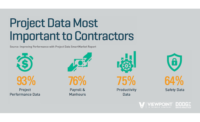The problem of dual entry and having to maintain parallel project management platforms remains a persistent problem in construction, according to a new SmartMarket Report from Dodge Data & Analytics.
Working from an online survey of construction owners and contractors, the report found that 42% of contractors reported that they had worked on a project where they had to use the owner’s preferred PM software alongside their own. Almost three quarters of contractors said double entry on multiple PM systems had impacted their productivity.
“We did hear reports of time being lost due to double data entry,” says Donna Laquidara-Carr, research director with Dodge’s Industry Insights. “Owners aren’t seeing that loss of time for the contractor. [The study finds] 42% of owners felt the contractor’s risk is not increasing due to this, but that’s wrong.”
“Since the dawn of project management systems, the notion of who owns what data and how you choose what to use it has been a source of conflict,” says Chris Bell, vice president of marketing for e-Builder, which commissioned the Dodge study. “Owners are leaning in and becoming authorities on how they want the project managed and have cost control. They’re getting into the software decisions.”
Bell says it commissioned the study based on some of e-Builder’s experience in working with large capital owners managing many projects. Tensions between owners and contractors over what system to use can come to a boiling point on some larger jobs, he says. “What this study really aims to do is measure the toxicity and prevalence of that dynamic,” says Bell. “How does that impact the contractor and owner?”
When owners are increasingly requiring contractors to use project management software, only 16% of contractors reported that they were already using the same PM software as the contractor. Having to work in both the owner’s and their own software is surprisingly common, especially on submittals.
According to Laquidara-Carr, Dodge found that contractors working in parallel PM systems increase the chance of errors in data entry, and PM systems can drift out of sync without committing extra labor to monitoring the systems. This is further constrained by the limited technology budgets many contractors have to work with. When we’ve spoken to contractors, it’s not that they’re resistent to technology—it’s that they have not lot of money to spend. They want biggest bang for buck,” she says.
“What we’re seeing here is that contractors are in a better position [regarding adoption of PM software] than where they were in the past, but it could be better,” says Laquidara-Carr. “Contractors are working to stay on top of new software, but as they gain more of an understanding they see the more they can do. The report really supports that contractors are still on that journey.”




Post a comment to this article
Report Abusive Comment